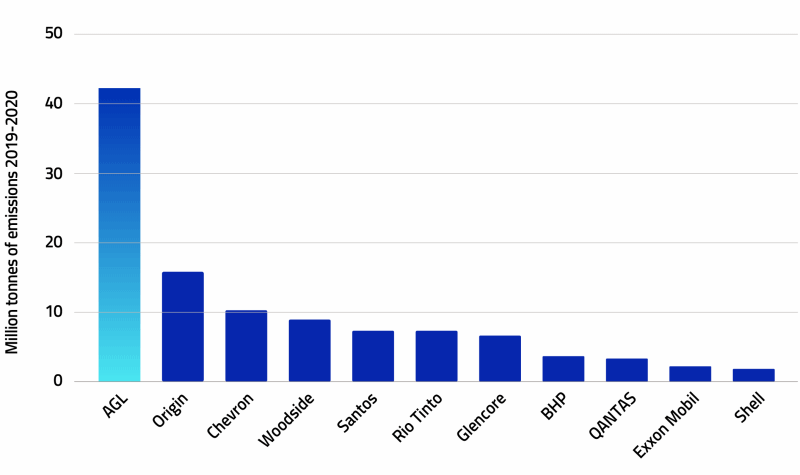AGL and Greenpeace Australia Pacific are readying to rumble over the latter’s latest climate change related campaign.
Last Wednesday, Greenpeace Australia Pacific launched a report titled “Coal-faced: exposing AGL as Australia’s biggest climate polluter“. This was accompanied by digital advertising campaign and the launch of AustraliasGreatestLiability.com
On Thursday evening, AGL’s legal team served the group with an application for an urgent interlocutory (interim) injunction, demanding Greenpeace remove AGL logos from its campaign. That application was heard in the Federal Court on Friday and the injunction was denied, but this isn’t over yet as the case returns to court tomorrow.
Senior campaigner for Greenpeace Australia Pacific Glenn Walker said his organisation is ready for a “David and Goliath” battle.
“This is yet another attempt by the coal industry to stop grassroots organisations from exposing the damage that it is doing to the climate, to the environment and to human health.”
Regarding the essence of its report, Greenpeace says:
“AGL has traded on its ‘sustainable’ image for years, trying to hide its dirty and climate-wrecking coal operations by masquerading as a renewables leader when 85% of the power it generates comes from dirty coal. This makes AGL Australia’s biggest domestic contributor to climate change.”

Graph from Greenpeace “Coal-faced” report
Greenpeace states AGL was responsible for more than 42 million tonnes of greenhouse gas emissions in 2019/20; more than 8 per cent of Australia’s total emissions.
AGL’s coal burners are:
- Bayswater power station- 2.6GW
- Liddell power station – 2GW (but operating below that in recent times)
- Loy Yang A – 2.2GW
The three facilities represent over a quarter of Australia’s coal power station capacity.
But..
For Liddell, The End Is Nigh
The days are numbered for clapped-out coal fired clunker Liddell, which is slated to starting closing next year after 50 years of wreaking atmospheric and other havoc. AGL reported on Friday that it had awarded the tender for the first stage of Liddell’s closure, decommissioning and demolition planning.
Bayswater is currently getting an upgrade that will provide more capacity without increasing coal consumption and emissions according to AGL. As for Loy Yang A, it’s pretty much business as usual – more dirty power and if history is anything to go by, more breakdowns.
But if AGL is making some solid progress in addressing carbon emissions, is Greenpeace being a bit harsh with such an intense campaign?
While waving ta-ta to Liddell will be a great thing, Loy Yang A and Bayswater’s continued operations for the foreseeable future are problematic – although increasingly cheaper wind and solar energy are really piling on the pressure regarding their ongoing viability. In March, EnergyAustralia announced the brown coal-fired, emissions-belching Yallourn Power Station will be retired in mid-2028.
But as SQ’s Ronald recently mentioned, given the dire situation we face:
“The amount of additional CO2 we can safely add to the atmosphere is zero.”
If both AGL’s remaining plants continue to operate until their intended end-of-life dates (Bayswater: 2035 and Loy Yang A: 2048), they’ll spew hundreds of millions of tonnes more greenhouse emissions before they are done and coal-dusted. Added to that are all the other toxic emissions and coal ash that will be produced.
Greenpeace is calling on AGL to retire all of its coal-burning power stations by 2030.
“The continued rise of clean energy is inevitable: it is not a question of if, but when, Australia will be powered entirely by renewables,” says Greenpeace.
.. and it’s the when that is so important now.


 RSS - Posts
RSS - Posts



AGL took the bait re: their logo in the ad. Now the Streisand effect kicks in and AGL can only lose the resulting PR war.
Surely the senior officers and board members of all the fossil fuel companies must know by now the ‘writing is on the wall’ and that they are in businesses that are in terminal decline? Many of them (presumably) have children and grandchildren that will inevitably be living on a more hostile planet (relative to the one they have already experienced) in future, due to their advocacy and efforts to continue their company’s operations that contribute to putting more GHG emissions into the atmosphere. IMO, politicians are also effectively advocating for civilisation collapse when they advocate for and support more fossil fuel developments and discourage low/zero emissions solutions. Why don’t they understand that what they are doing is pushing us/humanity closer to collapse? Is it short-term greed/power? Denial? No empathy?
NOAA Mauna Loa Observatory published the WEEKLY average for 25 Apr to 1 May 2021 that was at 420.01 ppm, the week previous to that was at 418.20 ppm, one year ago (2020) was at 416.95 ppm, and ten years prior (2011) was 393.48 ppm.
https://twitter.com/CO2_earth/status/1389276287248871428
Scripps Mauna Loa Observatory graphical data can be found here: https://keelingcurve.ucsd.edu/
Scientists know from the paleo-historical record, there was the so-called Mid-Pliocene Warm Period around 3–4 million years ago (long before our species, so-called homo sapiens, first appeared circa 300,000 years ago) where atmospheric CO2 levels were in the range of 400–450 ppm, global mean temperatures were +2.0–3.0 °C (above Holocene Epoch pre-industrial age), and sea levels were +10–22 m higher than today (stabilised over centuries) – see from time interval 0:24:51 to 0:26:45 in the YouTube video: https://www.youtube.com/watch?v=QK2XLeGmHtE
Barring super-volcanic eruption, major meteor impact, and/or global thermonuclear war event(s), the Earth System is ‘locked-in’ to surpass the +1.5 °C global mean warming threshold, likely before 2030, and on current GHG emissions trajectory, is likely to surpass +2.0 °C global mean warming threshold before 2050.
See Table 1 in: https://esd.copernicus.org/articles/12/253/2021/esd-12-253-2021.pdf
An important new paper in Nature (paywalled, except for Abstract) on Antarctic ice sheet loss was published on May 5, titled “The Paris Climate Agreement and future sea-level rise from Antarctica”.
https://www.nature.com/articles/s41586-021-03427-0
The authors of the Nature paper have also provided an accessible post at CarbonBrief, including:
“Once begun in earnest – after temperatures hit 2C at mid-century – Antarctic sea level rise becomes essentially unstoppable, even with a quick return toward pre-industrial temperatures. The loss of buttressing ice shelves and a warmer ocean holding its heat for many centuries prevents refreezing of Antarctica’s ice shelves. The results show that CO2 removal can slow, but cannot halt this massive ice loss once it begins.”
https://www.carbonbrief.org/guest-post-overshooting-2c-risks-rapid-and-unstoppable-sea-level-rise-from-antarctica
Included are graphs of rates and total amounts of sea level rise from Antarctica ice sheet loss (but not other contributions like ocean thermal expansion, glaciers and Greenland ice sheet) for 1.5, 2, 3 and 4.5 °C global mean warming (relative to pre-industrial age) by 2100 scenarios.
Michael Bloch, the compelling evidence I see indicates undeniably, as you say: “…it’s the when that is so important now.”